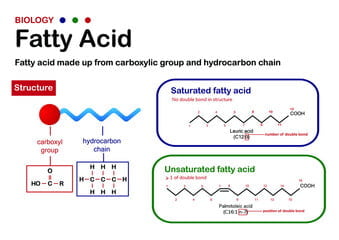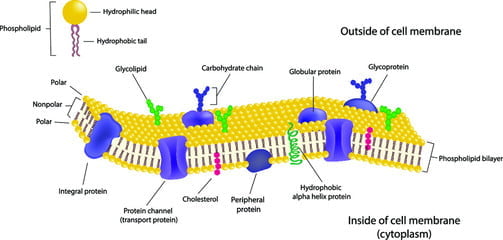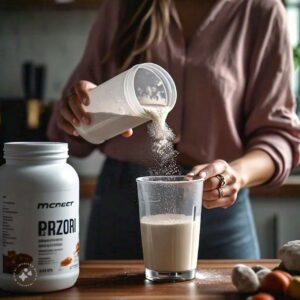Lipid are often misunderstood components of our diet and body composition. While commonly related to unhealthy fats, it play key roles in different physiological processes, from energy storage to cell structure. In this comprehensive guide, we’ll explore the world of it types, exploring their various classifications, functions, and significance in human health.
Overview
Different classes of organic molecules known as lipids are soluble in organic solvents like ether, chloroform, and benzene but insoluble in water. They are a fundamental part of living cells and perform a variety of important functions, like energy storage, maintaining the integrity of the cell, and cell signaling..
Types
It can be classified into different categories based on their chemical structure and properties. These classifications include:
- Phospholipids
- Steroids
- Triglycerides
- Glycerolipids
- Waxes
- Cholesterol
- Fatty acids
- Trans fats
I. Phospholipids
Phospholipids are a type of it composed of a glycerol backbone, two fatty acid chains, a phosphate group, and a polar head group. They are integral components of cell membranes, forming a lipid bilayer that regulates the passage of substances into and out of cells.
II. Steroids
Steroids are a class of it categorized by a four-ring structure. They assist many functions in the body, including hormone production, regulation of metabolism, and maintenance of cell membrane fluidity.
III. Triglycerides
Triglycerides, also known as triacylglycerols, are the most abundant type in the body and in the diet. They consist of a glycerol molecule and three fatty acid chains and help as a primary form of energy storage in adipose tissue.
IV. Glycerolipids
Glycero are composed of a glycerol backbone and one or more fatty acid chains. They are found in cell membranes and function as energy reserves.
V. Waxes
Waxes are esters of long-chain fatty acids and long-chain alcohols. They provide waterproofing and protection for plants and animals, serving as structural components of the cuticle in plants and as protective coatings on feathers, fur, and skin in animals.
VI. Cholesterol
Cholesterol is a molecule important for several physiological processes, including cell membrane integrity, hormone synthesis, and bile acid production. While excessive cholesterol levels can contribute to cardiovascular disease, it is also vital for overall health when maintained within normal limits.
VII. Fatty acids
Fatty acids are the building blocks of it and play key roles in energy metabolism, cell membrane structure, and signaling pathways. They can be saturated or unsaturated depending on the presence of double bonds in their carbon chain.

VIII. Trans fats
Trans fats are a type of unsaturated fatty acid with trans double bonds. They are primarily produced through hydrogenation and are commonly found in processed foods. Consumption of trans fats has been linked to an increased risk of cardiovascular disease and other health issues.
Conclusion
They are various molecules with important roles in the human body. Understanding the different types of lipids, their functions, and their impact on health is essential for making informed dietary choices and maintaining overall health. By appreciating the complexity and significance, we can better prioritize our health and nutrition goals.
Table
Sure, here’s a table listing different types:
| Type | Description |
|---|---|
| Triglycerides | Main constituents of body fat and vegetable oil; composed of glycerol and three fatty acids |
| Phospholipids | Major component of cell membranes; composed of glycerol, two fatty acids, and a phosphate group |
| Steroids | With a characteristic carbon structure, including cholesterol, testosterone, and estrogen |
| Waxes | Long-chain fatty acids esterified to long-chain alcohols; found in plants and animals |
| Sphingolipids | It’s containing sphingosine as a backbone; found in cell membranes |
| Glycolipids | With a carbohydrate attached; found in cell membranes and involved in cell recognition |
These are some common types , each with unique structures and functions in biological systems.
FAQS
Are Lipid tails hydrophobic?
Yes, tails are hydrophobic, meaning they repel water. This characteristic is due to the non-polar nature of lipid tails, which consists of long hydrocarbon chains that do not interact well with water molecules.
What are lipid made of?
These are primarily made of carbon, hydrogen, and oxygen atoms. They consist of diverse molecules such as triglycerides, phospholipids, and cholesterol, each with unique structures and functions in biological systems.
How lipid transport in blood?
That are transported in the blood primarily through lipoproteins, which are complex particles composed of lipids and proteins. These lipoproteins serve as carriers for it, allowing them to be transported through the watery environment of the bloodstream.
What lipid stores energy?
They are store energy in the form of triglycerides, which are composed of three fatty acid molecules bound to a glycerol backbone. These triglycerides are stored in adipose tissue throughout the body and can be broken down to release energy when needed.



